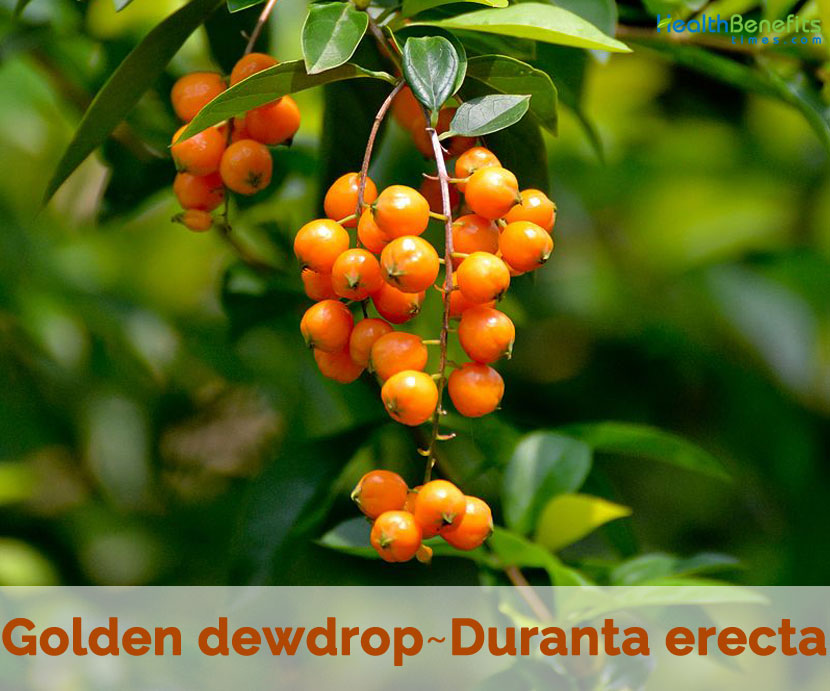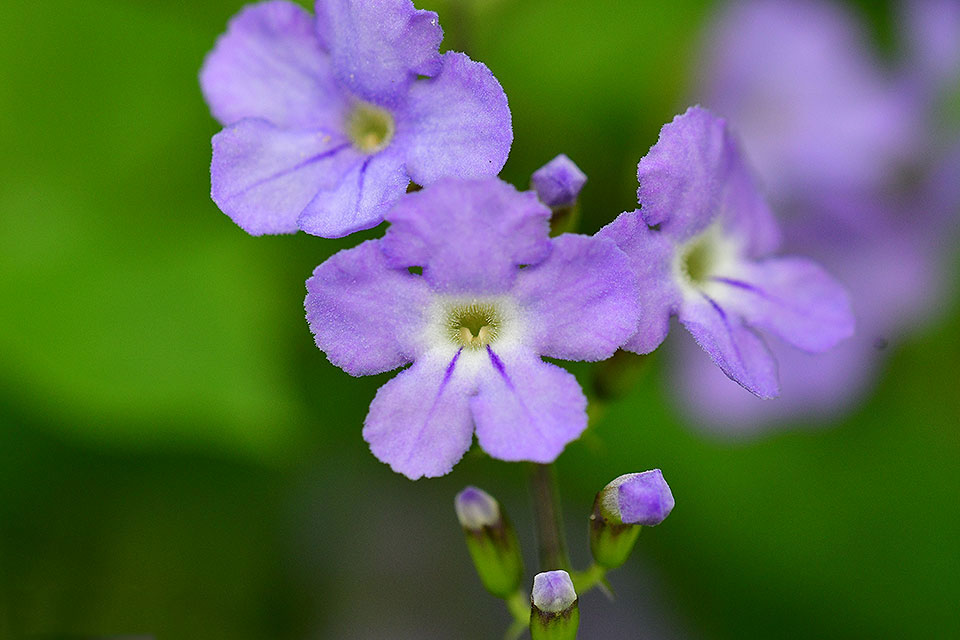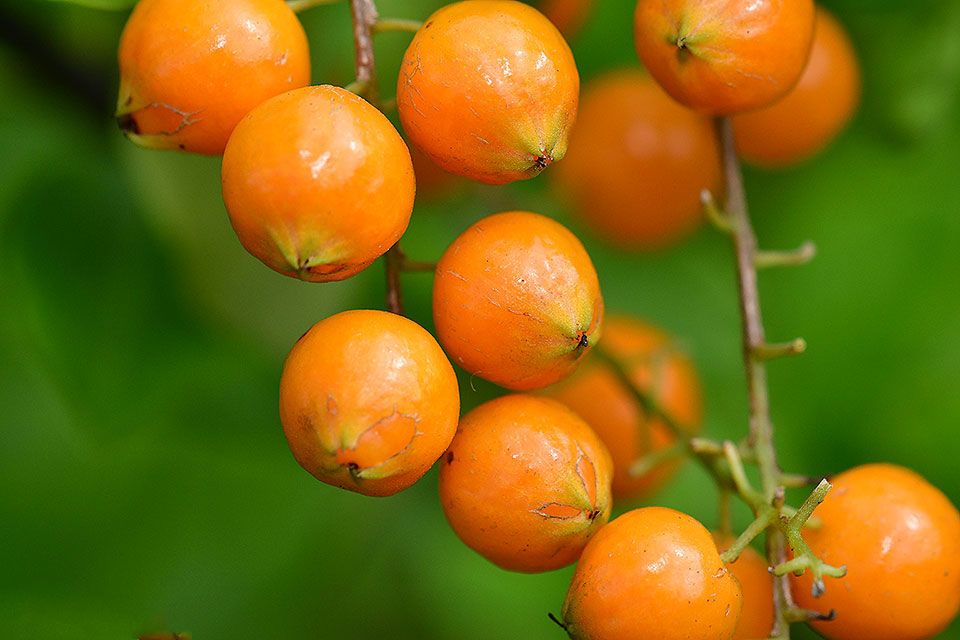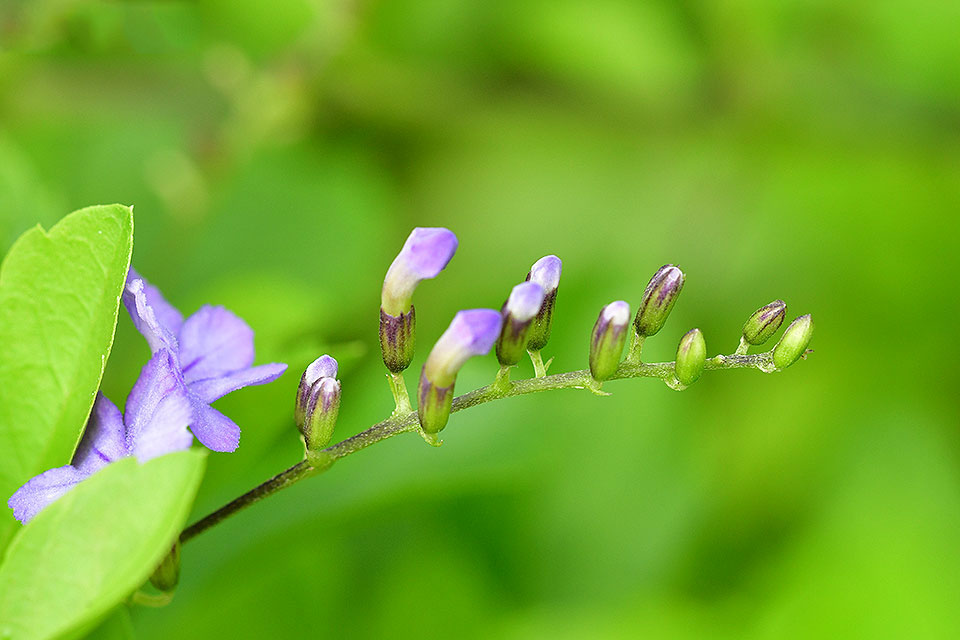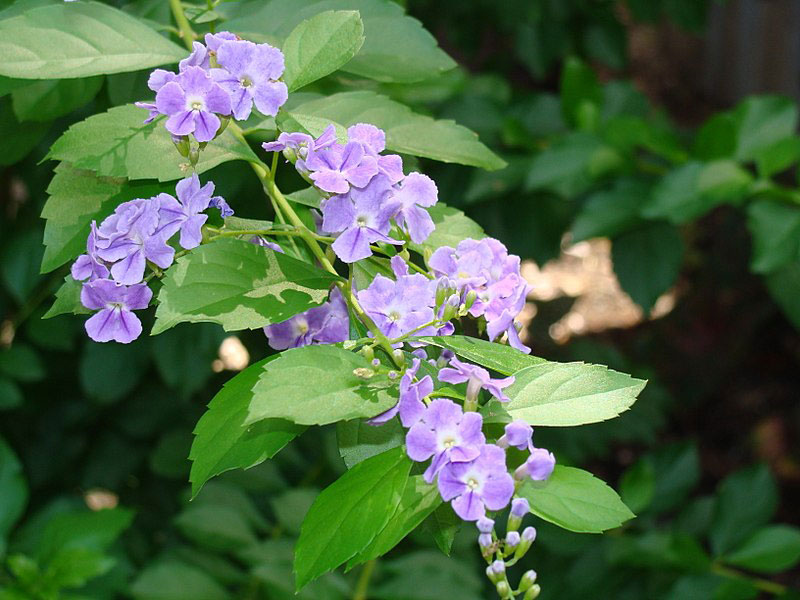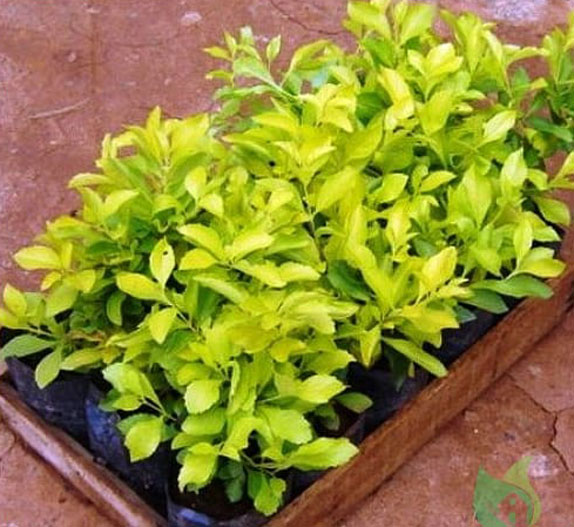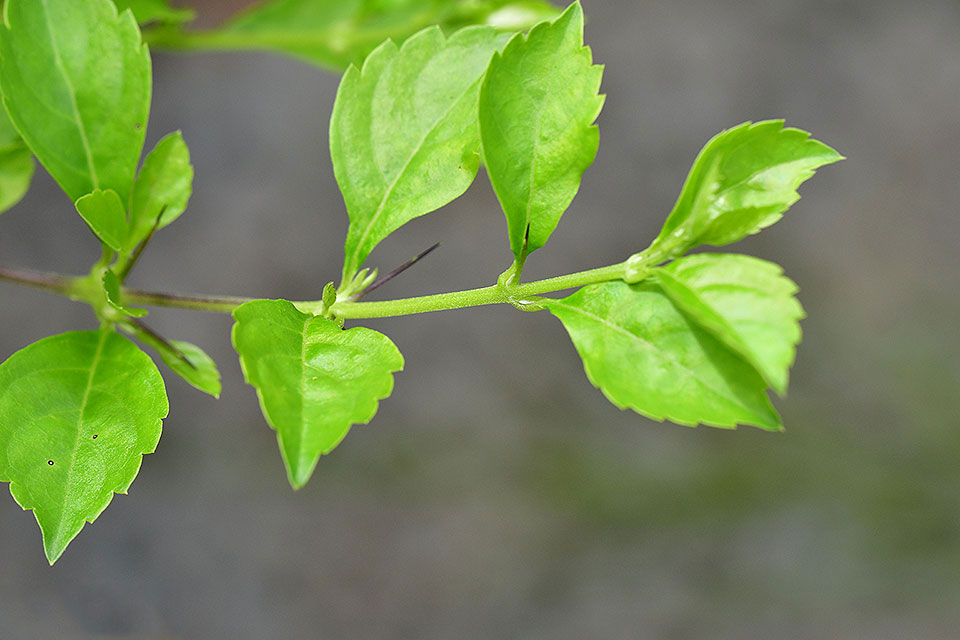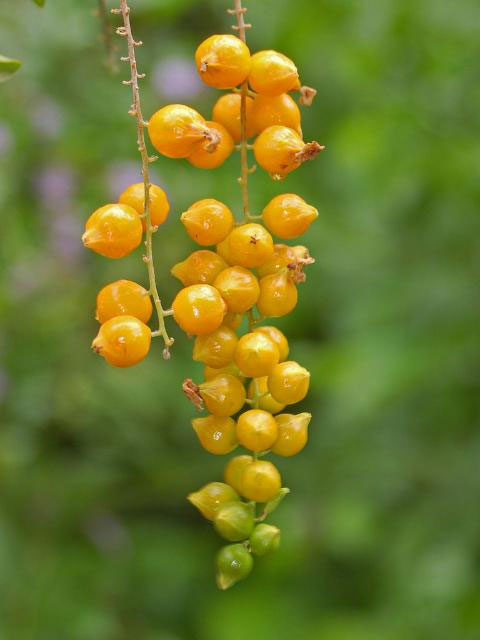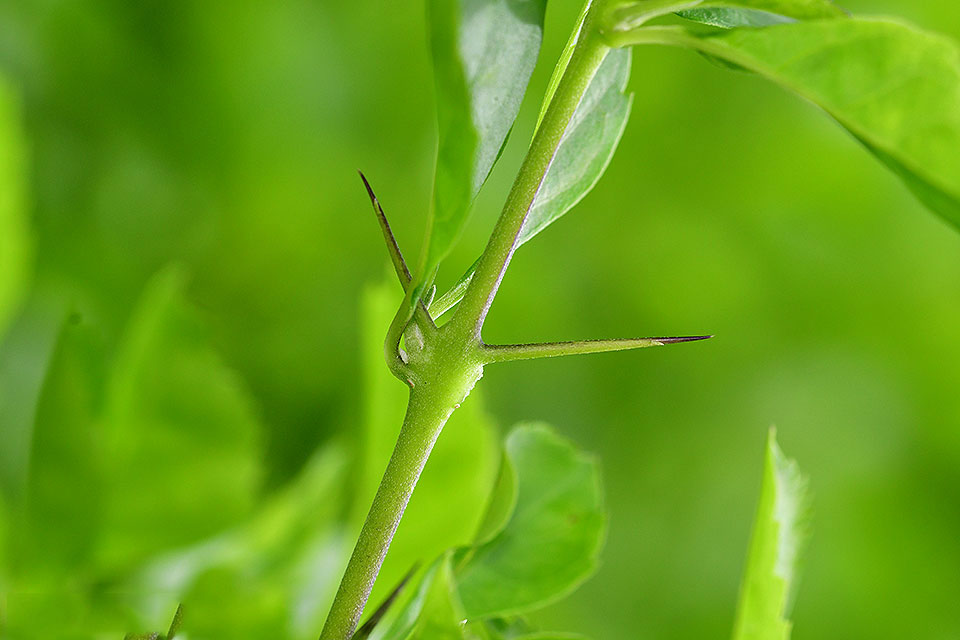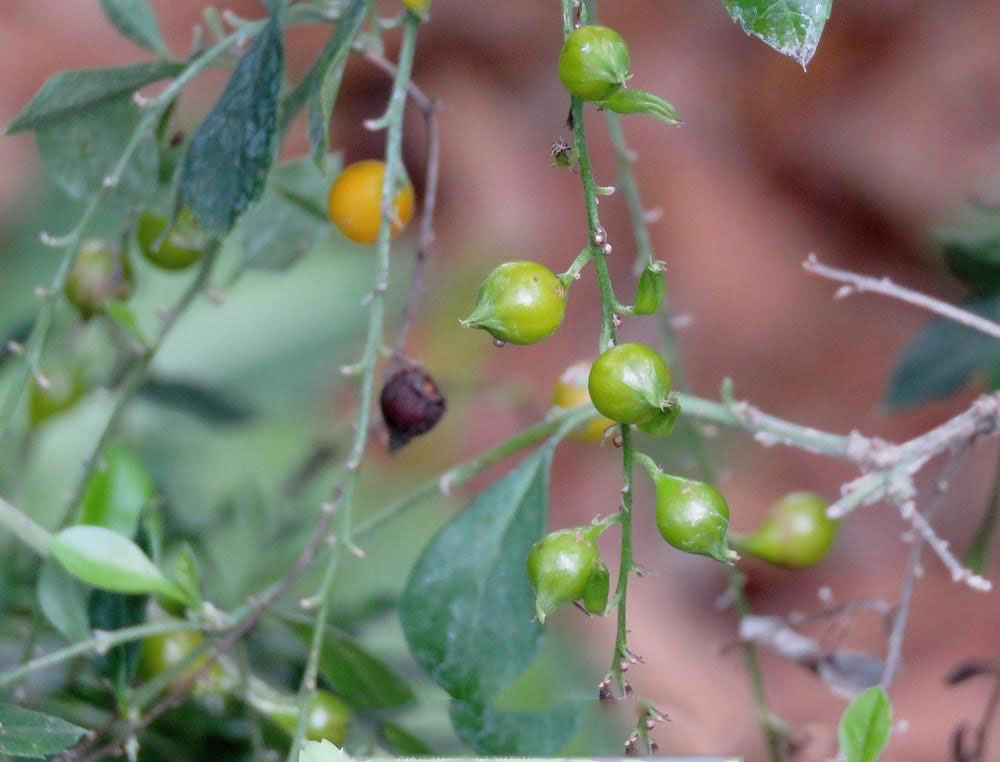Golden Dewdrops facts
| Golden dewdrop Quick Facts | |
|---|---|
| Name: | Golden dewdrop |
| Scientific Name: | Duranta erecta |
| Origin | Mexico, Central America, South America to Argentina, southern Florida |
| Colors | Initially green and then mature to a golden yellow to yellow-orange color |
| Shapes | Small globose fleshy, yellow or orange berry, up to 11 mm (0.43 in) diameter and containing several seeds |
| Health benefits | Beneficial for itches, infertility, fever, pneumonia, malaria, asthma, bronchitis, cataracts, abscesses and parasitism |
| Name | Golden Dewdrops |
|---|---|
| Scientific Name | Duranta erecta |
| Native | Mexico, Central America, South America to Argentina, southern Florida (possibly naturalized), Bermuda, the Bahamas, and the West Indies |
| Common Names | Golden dewdrop, Golden dewdrops, Pigeonberry, Skyflower, Vanilla bush, Forget-me-not tree, duranta, golden eardrops, angels whisper, Brazilian sky flower, garden dew drop, golden tears, Creeping skin flower, forget-me-not bush, pidgeon berry |
| Name in Other Languages | Afrikaans: Vergeet-my-nie-boom, Vanilla struik Assamese: Duronta-kanta,Jeora-goch Bengali: Kata mehedi Brazil: Pingo-de-ouro, violeteira-dourada Chinese: Jia lian qiao (假连翘) Dutch: Stoute jongens English: Golden dewdrop, Golden dewdrops, Pigeonberry, Skyflower, Vanilla bush, Forget-me-not tree, duranta, golden eardrops, angels whisper; Brazilian sky flower; garden dew drop; golden tears, Creeping skin flower, forget-me-not bush, pidgeon berry Finnish: Kultakastepensas French: Vanillier de Cayenne, durante dressée, durante; vanillier marron German: Durante, taubenbeere India: Kata mehedi, Bharangi Indonesian: Sinyo nakal Italy: Duranta Japanese: Deyuranta (デュランタ) harimatsuso (ハリマツソ), sinyo nakal, taiwan-rengiyô (タイワンレンギヨウ) Javanese: Sinyo nakal Kannada: Neelakantha Malayalam: Māṇikkyacempaḻukka (മാണിക്ക്യചെമ്പഴുക്ക) Marathi: Piwali Mendi, Piwalimendi Marshallese: Jab meloklok Mexico: Pojkol che, xcambocoché Nepali: Neel Kaandaa (नीलकाँडा) Philippines: Dueanta Portuguese: Duranta, fruta-de-jacú, pingo-de-ouro, violeteira Russian: Golubinaya yagoda (голубиная ягода), duranta Plûmʹe (дуранта Плюмье) South Africa: Vergeet-my-nie-boom Spanish: San Jacinto, cuentas de oro, duranta, flor celeste, blanco, adonis morada, celosa cimmarona, espina de paloma, fruta de iguana, tala blanco Swedish: Duvbär Thai: Thanh yod (เทียนหยด) Tonga: Mavaetangiz, olive, māvaetangi Uganda: Ekikomamahanga, kawololo, langwila Vietnamese: Thanh quan |
| Plant Growth Habit | Sprawling thorny, or vine-like tender evergreen shrub or small tree |
| Growing Climates | Scrub, open woodlands, disturbed areas, riparian habitats, coastal hills, grasslands, densely forested areas and roadsides, dry broadleaf evergreen formation, forests, shrub lands, pine woodlands, human altered environments, river banks, in scrubby vegetation of grazing paddocks, foreshore slopes in open forests |
| Soil | Tolerates acidic to slightly alkaline soils and is moderately salt tolerant. It prefers well drained, sandy, gravely, fertile soils and partial shade |
| Plant Size | Up to 6 m (20 ft.) tall and can spread to an equal width |
| Bark | Light gray, becoming rough and fissured when old |
| Stem | Square, herbaceous but woody below, erect, branched, solid, green. stems of mature plants usually have sharp axillary thorns, which are absent in younger plants of this species |
| Leaf | Light green, elliptic to ovate, opposite, and grow up to 7.5 cm (3.0 in) long and 3.5 cm (1.4 in) broad, with a 1.5 cm petiole. |
| Flowering season | May to September |
| Flower | Flowers are light-blue or lavender, produced in tight clusters located on terminal and axillary stems, blooming almost all year long. Flowers are scentless, borne on one side of the rachis, white or lilac-blue with two violet stripes, about 1 centimeter long and 1 centimeter wide. |
| Fruit Shape & Size | Small globose fleshy, yellow or orange berry, up to 11 mm (0.43 in) diameter and containing several seeds |
| Fruit Color | Initially green and then mature to a golden yellow to yellow-orange color |
| Propagation | By Seed and by cuttings |
| Plant parts used | Leaves, fruits, juice |
| Seed | Obovate-oblong, smooth, glabrous |
The genus name is in honor of Castor Durantes, a fifteenth century Italian botanist. The specific epithet erecta means “upright” in Latin. The plant is also known as D. repens, from the Latin for “creeping”. The latter name was initially used to identify smaller-leaved varieties of the species. Duranta is registered as an invasive weed by many councils of Australia. It is a prolific, fast growing weed that is spread by birds from domestic areas to natural reserves. It was introduced and marketed as a hedge plant some years ago. Many people now fight to keep this thorny pest under control. It is highly ranked in the most invasive weeds in Australia. The leaves and fruits are also poisonous to people and animals and they are reported to have caused the poisoning of domestic cats and dogs. It is reported to invade riparian habitats and scrublands and it is listed as one of the 50 most invasive species in New South Wales and among the top 100 most invasive plants in southeastern Queensland.
Plant Description
Golden dewdrop is a spreading, sprawling thorny or vine-like tender evergreen shrub or small tree that normally grows up to 6 m (20 ft.) tall and can spread to an equal width. It is widely cultivated as an ornamental and is also used as a hedge plant. The plant is found growing in scrub, open woodlands, disturbed areas, riparian habitats, coastal hills, grasslands, densely forested areas and roadsides, dry broadleaf evergreen formation, forests, shrub lands, pine woodlands, human altered environments, river banks, in scrubby vegetation of grazing paddocks and foreshore slopes in open forests. The plant tolerates acidic to slightly alkaline soils and is moderately salt tolerant. It prefers well drained, sandy, gravely, fertile soils and partial shade. Stem is square, herbaceous but woody below, erect, branched, solid, green. Sharp axillary thorns are usually present on stems of mature plants, but are usually absent on young plants. Bark is light gray, becoming rough and fissured when old.
Leaves
Leaves are light green, elliptic to ovate, opposite, and grow up to 7.5 cm (3.0 in) long and 3.5 cm (1.4 in) broad, with pointed or rounded tips and pointed base; the margins, entire or slightly toothed. Petiole is 1.5 cm long.
Flower
The zygomorphic, perfect, complete flowers are arranged in terminal and axillary pendulant racemes blooming almost all year long. The calyx has 5 fused greenish sepals. The corolla has 5 fused purple-pink petals often with a white edge and/or striping. There are 4 functional stamens and 1 staminode that are fused to the throat of the corolla. The ovary is superior with 4 locules and multiple ovules. Flowering normally takes place from May to September. The full clusters of fragrant, pale blue flowers attract butterflies in summer.
Fruits
Fertile flowers are followed by small globose fleshy, yellow or orange berry, up to 11 mm (0.43 in) diameter and containing several seeds. The berries change color from orange to a dark purple similar to mulberries once ripened and are edible without side-effects. However, songbirds eat the fruit without ill effects. The seeds of this species are dispersed naturally by birds that eat the fruits, and accidentally through garden waste disposal by humans and the nursery trade.
Flowers and fruit are often found on the plant simultaneously and make an attractive show. Yellow fruit often hangs on the plant into the winter if the birds don’t eat them.
Traditional uses and benefits of Golden dewdrop
- Flowers are believed to be stimulant. (1)
- Infusion of leaves and juice of fruit are diuretic. (2), (3)
- Leaves used for treatment of abscesses. (4)
- In Bangladesh, tribal and mainstream use for malaria. Also used by mainstream Kavirajes as insect repellent, treatment of itches, infertility, fever, and pneumonia. (5)
- Decoction of whole plant used for asthma, bronchitis, and fever in Andhra Pradesh, India. (6)
- In India, leaves and stems used for treatment of cataracts. (7)
- In the southeastern part of Nigeria, fruits used for treatment of malaria, abscesses, and parasitism. (8)
- Its fruits are used as febrifuge and are a treatment for malaria and intestinal worms. (9)
Other Facts
- D. erecta is cultivated as an ornamental and as a plant used in hedges and windbreaks.
- It also has medicinal uses in China.
- The wood is light brown and hard and useful for stakes and fuel.
- Fruit juice is also known to be used against mosquitoes.
Precautions
- Leaves and berries of the plant are toxic, and are confirmed to have killed children, dogs and cats.
- Golden dewdrop is a poisonous plant and has caused deaths of children.
- Saponins in the fruits and foliage cause gastro enteric irritation, drowsiness, fever, nausea, vomiting, and convulsions.
- Fruit is slightly poisonous with alkaloid type reactions.
- Deaths have been reported from ingestion.
References:
https://www.itis.gov/servlet/SingleRpt/SingleRpt?search_topic=TSN&search_value=502187#null
http://www.hear.org/pier/species/duranta_erecta.htm
https://www.cabi.org/isc/datasheet/20192
https://plants.usda.gov/core/profile?symbol=DUER
https://npgsweb.ars-grin.gov/gringlobal/taxonomydetail.aspx?id=405771
https://en.wikipedia.org/wiki/Duranta_erecta
https://enacademic.com/dic.nsf/enwiki/11600989
http://www.theplantlist.org/tpl1.1/record/kew-65221
http://www.flowersofindia.net/catalog/slides/Sky%20Flower.html
https://indiabiodiversity.org/species/show/266148
http://www.stuartxchange.org/Duranta
https://gd.eppo.int/taxon/DUTPL


